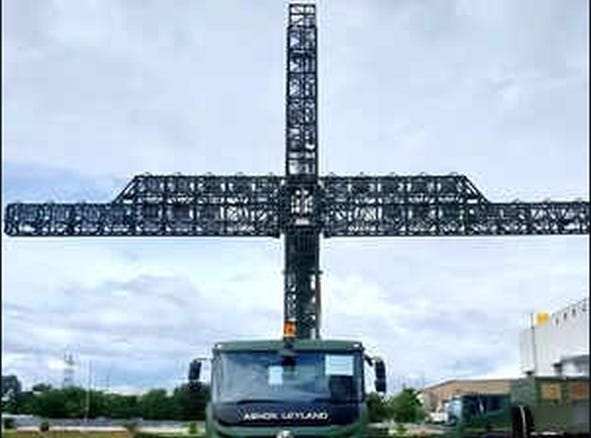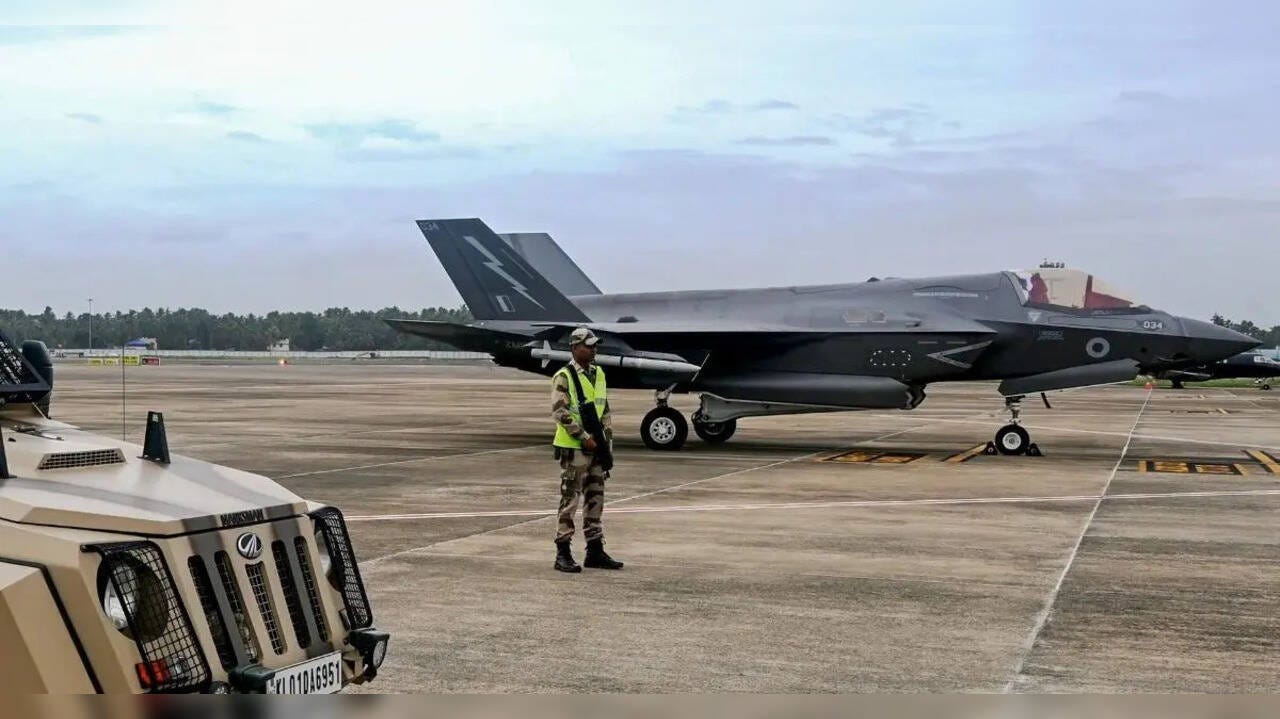F-35B Emergency Landing in Kerala: What Happened
On 14 June 2025, a Lockheed-Martin F-35B stealth fighter of the Royal Navy, operating from aircraft carrier HMS Prince of Wales, made an emergency landing at Thiruvananthapuram Airport, citing bad weather and low fuel while underway about 100 nautical miles off India’s coast. Detected by the IAF’s IACCS network, it was granted landing permission. Shortly after, a “hydraulic failure” rendered the $110 million jet unflightworthy — stranding it on a civilian tarmac.
***
Stranded on the Tarmac Amidst Security Concerns
Twenty-two days on, the F-35B has finally been sent to the hangar for inspection and repair attempts by the British engineers, after it sat exposed, for 18 days, to monsoon rains, guarded by India’s armed forces. Throughtout this time, British authorities refused hangar access, citing concerns over its stealth coatings, sensors, and proprietary tech. Analysts pointed to deeper trust issues: fear of tech leaks, and India’s outsider status in the F-35 program. The US hasn’t shared full source codes even with the UK — only Israel holds limited access. The incident occurred amid Washington’s push for India to buy F-35s, making this standoff a revealing glimpse into NATO’s tech paranoia.
Trivandrum Airport is an earmarked airfield for emergency landings under India-UK military cooperation understanding. Although not legally obliged to do so, New Delhi permitted the grounded F-35B to remain on its soil — a gesture that many read as either strategic realism or calculated ambiguity. India also tolerated the British instructive hesitance to move the jet into a hangar that, at face-value, was based on abundant caution about security concerns, although reeking of mistrust and colonial hangover — a reflex to treat Bhārat as a subordinate Commonwealth entity, not a peer.
Yet India showed restraint, even as tensions with the U.S. had risen post-Operation Sindoor, where Trump’s ‘ceasefire´-claims clashed with Modi’s direct rebuff. Initial repair attempts by Royal Navy technicians failed. Eventually, a 40-member UK team and specialized equipment were flown in, reversing earlier secrecy concerns. If repairs failed again, British contingency plans included airlifting the fighter out — a dramatic exit for a jet that had overstayed its (un)welcome landing both technically and diplomatically.
***
Speculation vs. Official Narrative
The F-35B’s unscheduled landing triggered a wave of theories — from a ‘NATO stealth test’ to ‘India jamming the jet mid-air’. The timing, just a day after Israeli strikes on Iran, only fueled talk of covert ops. Some claimed India exposed NATO surveillance; others said the UK feigned an emergency to test India radar coverage….
However, all official channels insisted it was ‘routine’: the result of a combination of low fuel, bad weather, and hydraulic failure. The Indian Air Force (IAF) emphasized humanitarian cooperation, and no formal protest was made by the UK or US. Experts noted the F-35’s recurring technical failures, grounding episodes, and poor maintenance record — making a real malfunction plausible.
Still, espionage couldn’t be ruled out entirely. British media stressed that the jet followed protocol and was detected and guided in by India’s systems — a subtle nod to both stealth vulnerability and IAF preparedness. No evidence of a deliberate breach emerged — just a stranded stealth jet, and a thousand whispered suspicions.
Why the F-35B landed in Trivandrum, bypassing friendlier airstrips like Oman or Maldives, remains a puzzle. A hydraulic failure taking nearly three weeks to fix — with no success — made the jet look less like NATO’s crown jewel and more like an uncrackable UFO. British engineers, baffled and ineffective, only deepened the mystery.
***
F-35 Reliability Under Scrutiny
This incident unintentionally put the F-35’s dismal reliability in the spotlight. The U.S. Department of Defence’s (DoD’s) own data confirms all F-35 variants routinely underperform on critical failure benchmarks. The B and C models have never met minimum reliability targets. Even the A variant barely scraped by once.
India, meanwhile, continues to resist Washington’s carrot-stick strategy: sell the F-35, block Russian defense ties. The Kerala fiasco ironically validates India’s skepticism. An aircraft so advanced it can’t fix itself without a support circus, isn’t a strategic asset: it is a logistical liability. The delay, complexity, and fragility of the F-35 program have once again been exposed — this time, in full public view.
The F-35’s reliability issues aren’t theoretical — they’re global. From South Korea’s 2022 belly landing and fleet-wide grounding, to British and American carrier crashes into the Mediterranean and South China Sea, the jet’s record is patchy. Japan’s 2019 crash, which scattered stealth tech into the Pacific, even raised fears of adversarial retrieval.
Since its debut, the F-35 has suffered dozens of incidents — from ejection seat checks to software failures. Each mishap chips away at its invincibility narrative.
The Kerala debacle only amplified that scrutiny — and India’s humor. Memes listed the F-35B for online resale, while one viral gag invoked “Award Anhsuman,” the overconfident and smug road-roller mechanic talented in remorselessly wrecking an otherwise eminently repairable machine, from a “Jhonny Lever” comedy — who is called in after the Americans and British engineers failed.
Yet beneath the laughter lies real strategic caution. Lockheed-Martin’s flagship fighter, despite a decade in service, still needs a small army to stay airborne. For India, the message is clear: stealth shouldn’t come with a support truck convoy.
***
Stealth Technology and Compromise Fears
Stealth is the F-35’s crown jewel — and its greatest vulnerability. Any exposure outside secure NATO hands triggers alarms of tech compromise. In Kerala, the intact but grounded jet sat unshielded for weeks in a non-F-35 nation. While India forces maintained strict distance and security, the West still held its breath. NATO’s history — from recovering crashed jets to even CIA’s Project Azorian — shows how far it’ll go to shield such secrets.
Plans to airlift the jet out if repairs failed weren’t just logistics: they were insurance.
***
India’s Electromagnetic Warfare and Stealth-Detection Capabilities
Meanwhile, India’s radar network had no trouble detecting the jet - to some degree certainly because it was equipped with radar reflectors, as is often the case during routine, peace-time operations. Though the F-35 cooperated, it highlighted IAF’s growing EM surveillance capability driven by investment in Integrated Air Command and Control System (IACCS) and sensor coverage. More importantly, it teased India’s stealth-countermeasures: foremost the indigenous Surya VHF radar, built by DRDO to detect low-observable threats. With Surya deployed in 2025, India’s ability to track stealth aircraft over vast distances has matured — even without the country operating such types.
The West guards its stealth. India watches it — quietly, but clearly.

However, detection is just step one.
DRDO’s Samyukta and Him Shakti EW systems give India the ability to jam, deceive, or blind enemy aircraft — from HF to microwave bands. These systems enable ELINT, ECM, and radar/data disruption. Fighter jets like the Su-30MKI now carry indigenous EW pods capable of targeting stealthy intruders mid-flight.
There’s no public evidence of EW use against the F-35B that landed in Kerala. But the possibility — and India’s capability — isn’t lost on observers. As the numbers of J-20s operated by the People’s Liberation Army Air Force (PLAAF - Chinese air force), and Pakistan’s ambitions rise, India is preparing not just to see stealth, but to dismantle its advantage. The F-35’s radar handshake in Thiruvananthapuram proved one thing: India’s eyes are very much open.
IAF sensors likely captured valuable EM emissions from the F-35B. Even without active snooping, passive SIGINT could yield strategic insights. With India’s growing stealth-detection and EW arsenal, any foreign stealth jet — ally or adversary — entering India skies now flies under deep, invisible surveillance.
***
India’s Counter to British-US F-35’s Digital Surveillance Crusade — Electromagnetic Kill Without a Shot?
Some of theories about the reason for the F-35B’s landing Thiruvananthapuram Airport are heading in their own direction. For example, although officially chalked up to bad weather and hydraulic failure, the Kerala incident may mark the world’s first non-kinetic air dominance victory — an electromagnetic (EM) kill without a shot.
The F-35B sat grounded for 21 days, digitally unresponsive even after intensive repair attempts. But this behavior isn’t random — it’s by design. The F-35 is built to “brick” itself under perceived signal corruption, shutting down external access and sensor fusion in a failsafe lockdown. It becomes a cyber-fortress in catatonia — which is exactly what unfolded in Thiruvananthapuram.
Many in India are wondering: why didn’t it land at Diego Garcia or Oman? Why India? Unless it was jammed, spoofed, or rerouted mid-air — Occam’s Razor says this wasn’t coincidence.
And if India did jam it, why no diplomatic uproar?
The reason appears to be on hand: because in cyber warfare, silence is often the price of knowing. If India had insight into how to ‘unbrick’ the jet, that becomes leverage. The muted response from the US and UK — no protests, no retaliation — resembles no innocence, but quiet re-calibration.
If so, then this wasn’t just a glitch. This was a ghost kill.
The UK’s refusal to move the F-35 into a India hangar wasn’t protocol — it was panic. A forensic look might’ve exposed a failed spy mission. And given NATO’s rich history of technical espionage by military means, suspicion here isn’t paranoia, it’s precedent.
When a stealth jet crashes with a textbook excuse, don’t dismiss the espionage angle. Bad weather and fuel issues are classic covers. This mission didn’t just malfunction — it walked and quacked like a spy.
1. Digital Warfare in the Age of Sensor Fusion
The F-35 is a sensor-fusion platform, relying on radar, GPS, IRST, and terrain mapping to remain situationally aware. EM jamming disrupts this input harmony, triggering an ‘untrusted state’. When confused, the jet shuts down — ODIN cloud refuses to connect, weapons go safe, systems brick. This isn’t a malfunction — it’s deliberate self-preservation. The Kerala F-35 likely entered this lock-down mode, needing NATO ground access to revive from digital paralysis.
2. Why Replacing Parts Doesn’t Work
EM jamming corrupts the F-35’s sensor trust-chain, triggering “fusion paralysis.” New parts fail not due to defects — but because the jet’s reality no longer matches memory.
3. Real War Implication: No F-35 Safe Near India Shores
If India really did this, and can replicate such a feat at war, F-35s won’t be shot down — they’ll self-disable mid-air. That would be India’s new doctrine: scramble the senses, not the skin.
4. Strategic Outcome
The Kerala incident may mark the first electromagnetic kill in airpower history — a stealth jet neutralized mid-air without a missile fired, and without a word spoken.
If India’s EW systems scrambled the F-35B’s sensor trust-chain, even future platforms like the B-21 Raider aren’t safe. This is civilizational warfare, not dogfighting. ‘We won’t chase you. We’ll just make sure you stop trusting your senses’.
The F-35 may have fulfilled a covert ELINT role. Or failed one. Either way, NATO got its stealth war reality check — because real supremacy isn’t built on simulations. It’s earned, sensed, and sometimes… spoofed.
***
Beating the US at Its Own Game
During Operation Sindoor, Trump attempted to humiliate India - whom it calls an ‘ally’ - diplomatically, while embracing Pakistan’s Asim Munir in a beef-lunch diplomacy. Now, with global tensions simmering, Iran and Russia are surely eyeing India’s EM tech that could brick NATO’s stealth fleet mid-air.
Though the F-35B isn’t certified to deploy nuclear weapons, it can carry tactical nukes. That makes its presence in Indian airspace more than just awkward: for many in India - where there is lots of mistrust for the USA - it is little else but a strategic provocation.
India’s response is clear: don’t mistake silence for submission. We won’t fight Western proxy wars. We’ll raise the cost of playing them. And next time, we might not stay quiet.
***
Monitoring the Geo-Strategic Radar
The F-35B’s stranding exposed a core truth: India, despite being a major defense partner, is still viewed with suspicion by the West. British refusal to allow India technicians near the jet underscored lingering trust deficits. India isn’t hostile — yet it’s treated as such. The U.S. has dangled F-35 sales for years, while pressuring India to distance from Russian systems like the S-400.
Trump’s February 2025 statement about offering F-35s raised hopes — but delays in deliveries of US-made General Electrics for India’s Light Combat Aircraft program, and the F-35’s black-box architecture highlight how little operational sovereignty such deals offer. The ALIS/ODIN system remains a key concern, with India wary of relying on platforms it cannot fully control.
The Kerala incident gives India a firsthand look at F-35's support demands, reliability limits, and the diplomatic friction they bring. AMCA remains years away, but blind trust in Western tech is no longer assured.
Meanwhile, India public sentiment turned the fiasco into a narrative win — memes, “parking fee” jokes, and Atmanirbhar pride trended as the nation watched a $100M NATO jet sit helpless. For India’s military planners, the real lesson is stark: stealth warfare is coming, whether via American, Chinese, or other actors. Preparedness is no longer optional — it's existential.
***
Sources
Arpan Rai, The Independent – “British F-35 jet stranded at India airport amid growing concerns over classified technology” (25 June 2025) the-independent.com
Sushim Mukul, India Today – “Tow trolley, 40 staffers from UK as F-35 refuses to leave Kerala even after 13 days” (27 June 2025) Indiatoday.in
Onmanorama (Kerala) – “Stranded F-35B fighter in TVM not a good sign for Trump and Lockheed Martin” (27 June 2025) onmanorama.com
Bhaskar English – “Full story of Britain’s F-35 jet stranded in Kerala: Why the missile-equipped aircraft stands exposed…” (28 June 2025) bhaskarenglish.in
Economic Times (India) – “India develops anti-stealth ‘Surya’ VHF radar…” (26 May 2025) economictimes.Indiatimes.com
Kyle Rempfer, Air Force Times – “China won’t find lost F-35 stealth fighter first, says Pentagon” (22 Apr 2019) airforcetimes.com
Al Jazeera News – “US Navy working to recover F-35 from South China Sea” (26 Jan 2022) aljazeera.com
Wikipedia – “Samyukta electronic warfare system” (accessed 2025) en.wikipedia.org (for general description of India’s EW system).
Wired – “Why Only Israel Can Customize America's F-35 (At Least for Now)” (18 May 2016)
***
About the Author
Shashanka Shekhar Panda has been a Chevening Fellow (2014) at King’s College London, is a public policy strategist and the author of “Victory Restrained: A Study of the Coherence of Bharatiya Diplomacy in Strategic Messaging in Operation Sindoor”. His work focuses on India’s evolving national security architecture, civilizational statecraft, and the intersection of economic and strategic interplay. He has previously worked across the private and public sectors, including as a senior equity analyst and a public policy strategist in the renewable energy domain. He holds a Bachelor’s degree in Commerce with Honours in Company Law and Management from Banaras Hindu University (Class of 1999). He is currently based in New Delhi, India, and working on a book on geostrategy, designed as a liminal convergence of fiction and non-fiction






Did Sarcastosaurus' substack get hacked? Compared to what's normally to be found here, this belongs in the junk mail.
Most of it comes across as trash that nationalists on our side want you to believe. Let's say it all happened. What are the hints that you are relying on? Other than the question of why it landed in India, and it's a logistical nightmare, I see only unnecessary jargon and speculation/conspiracy theories. I have little experience with radars and stuff, and all this sounds very implausible. All this crap about bricking-sensor fusion etc, sounds very implausible. And even if it is true, how do you know? And, of course, for an article making such tall technical claims, the sourcing is thin. I mean, don't cite news articles when making claims like this?